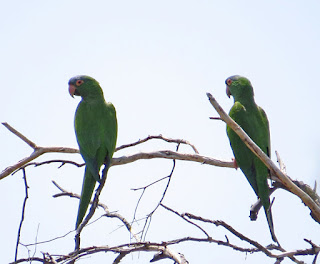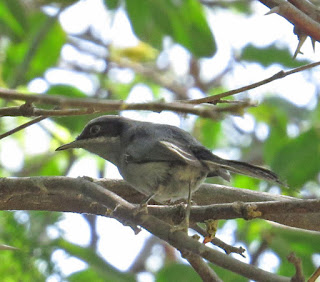September
19, 2015
Today was
our full day in the heart of Bolivia’s “Valle Zone,” with the Mizque and Caine
Rivers draining most of it through the Rio Grande, which itself eventually
flows north to the east of Santa Cruz and eventually into the Amazon via the
Rio Madeira. We started with a picnic breakfast in the cactus forest on our way
to Saipina. This looks very much like the cactus forests of parts of Mexico,
such as the Oaxaca Valley, and indeed we are at the same latitude south the
Equator here as Oaxaca is north of
it.
But the
birds are very different For example, this Spot-backed Puffbird was right
across the street from our picnic breakfast.
And this White-fronted
Woodpecker (appropriately named Melanerpes
cactorum) was on the same side of the road as our breakfast.
Not far down
the road was this White-tipped Plantcutter, an unusual cotinga of dry country.
There are
three parrots we hoped to see in this valley, all endemic to this and nearby
river systems, and apparently dependent upon the cliffs or cacti for nesting.
First and foremost was the Red-fronted Macaw, which we had seen quite closely
yesterday, but only in flight and from below. We succeeded this morning in
finding just one pair that would perch where we watched them at length through
the spotting scope. Sometimes we find birds feeding in a field or lounging in a
willow tree, but the view on these cliffs below us would be our best.
One of the
other two parrots we also looked for, and saw very well, were the Monk
Parakeets that look, sound, and nest differently from the Monk Parakeets found
in the lowland Chaco region and southward. These most certainly should be split
and called Cliff Parakeets. That they were lumped looks like merely an error
made by someone who hadn’t had any experience with them in the field.
The same
might be said about these Blue-crowned Parakeets, currently only as the
subspecies neumanni, but also quite distinct, isolated from lowland birds and
therefore yet another tick on our “escrow” lists.
We then had
lunch in the shade of a large mesquite tree (a different species than the ones
we have at home, but the same genus, Prosopis).
By tooting
like a Ferruginous Pygmy-Owl I brought in quite a mob that included Brown-capped
Redstart…
…and Masked
Gnatcatcher, among several other species.
Lots of
plants here are also found in the Chaco region, but some are also endemic. This
is Capparis tweediana.
I think this
cactus is Opuntia salmiana.
A very
distinctive, mostly leafless species of mesquite is this Prosopis kuntzei.
Finally, a
couple birds we saw on our drive back to Camiri, near which we found our
finally endemic of the day, Bolivian Earthcreeper (which is no more and no less
distinct than the Chaco Earthcreeper, but inconsistently has been considered a
separate species all along). We made a quick stop for this Cliff Flycatcher.
and one last
stop to hope for close-perched macaws resulted in this migrant Crowned Slaty
Flycatcher right below the road.




















No comments:
Post a Comment